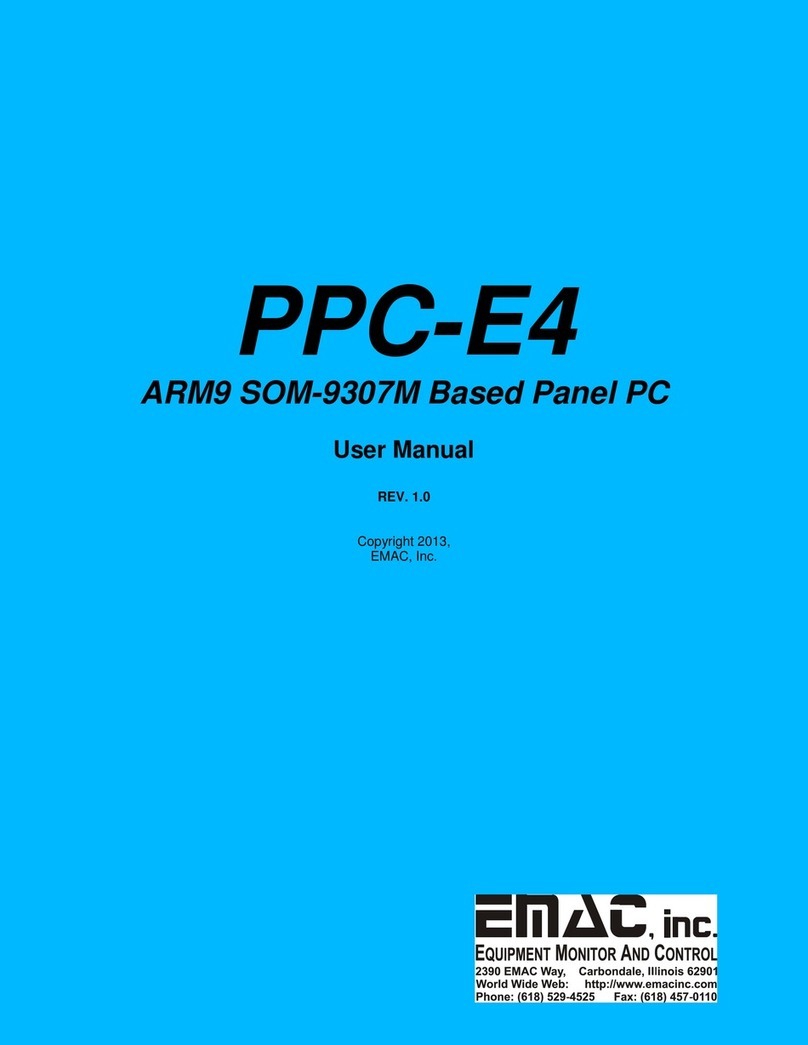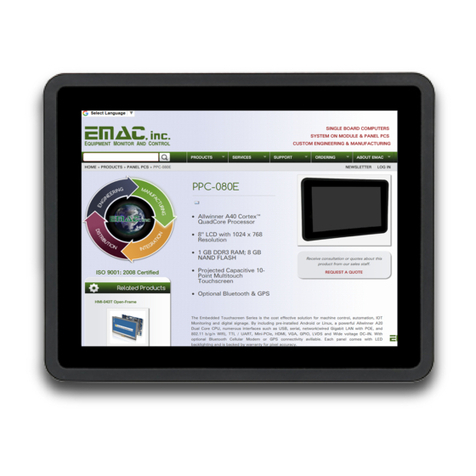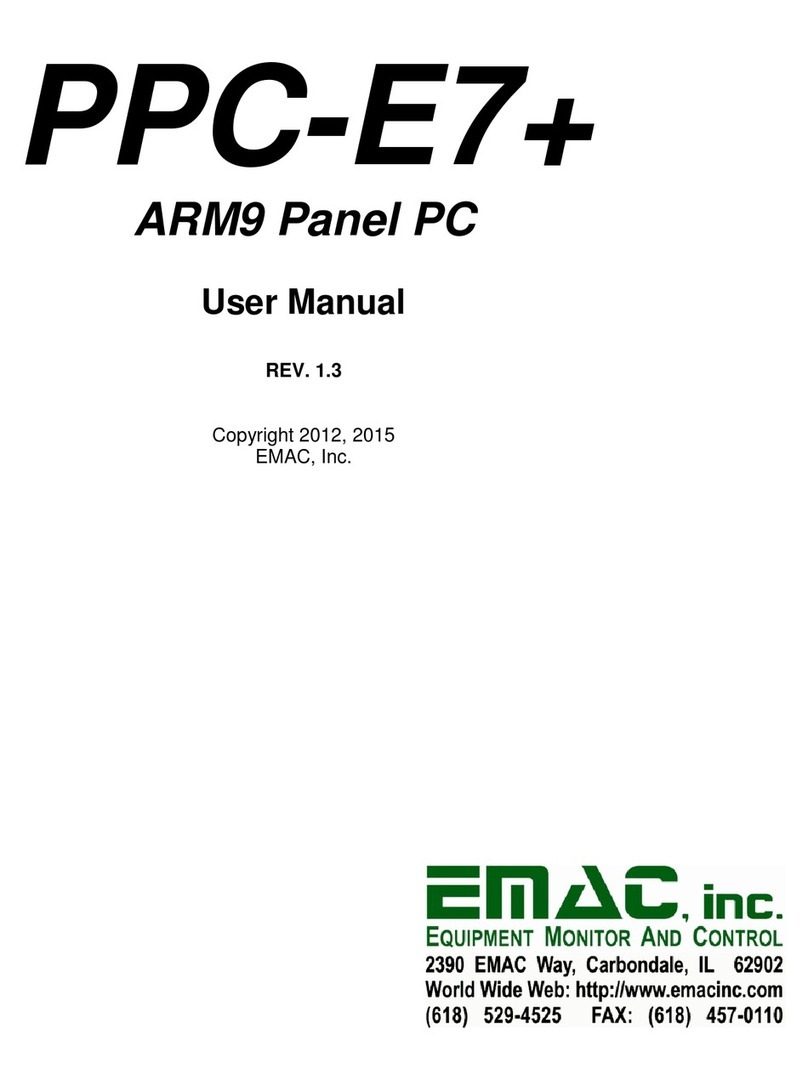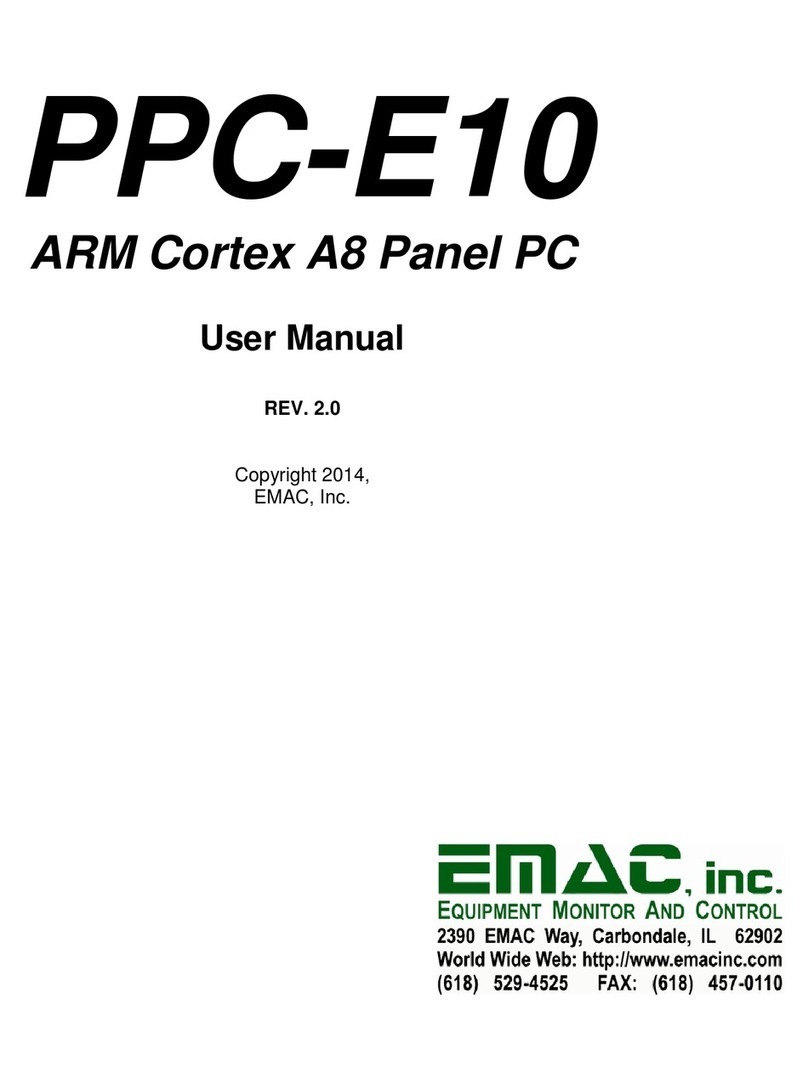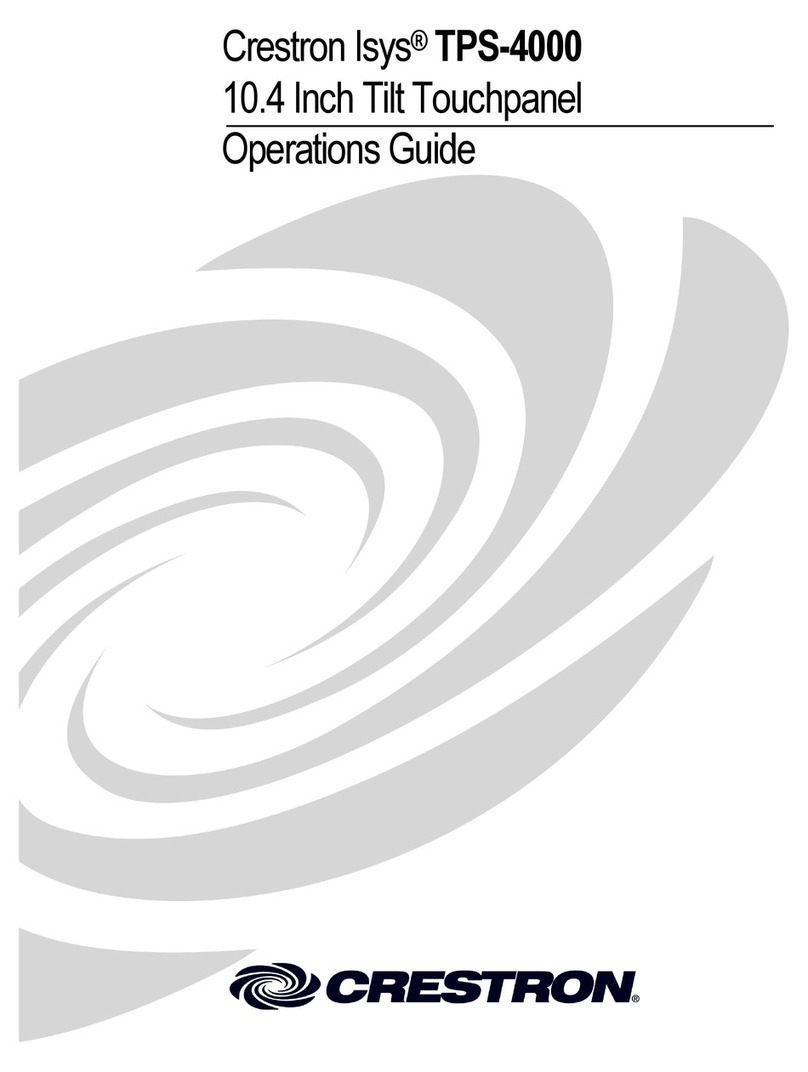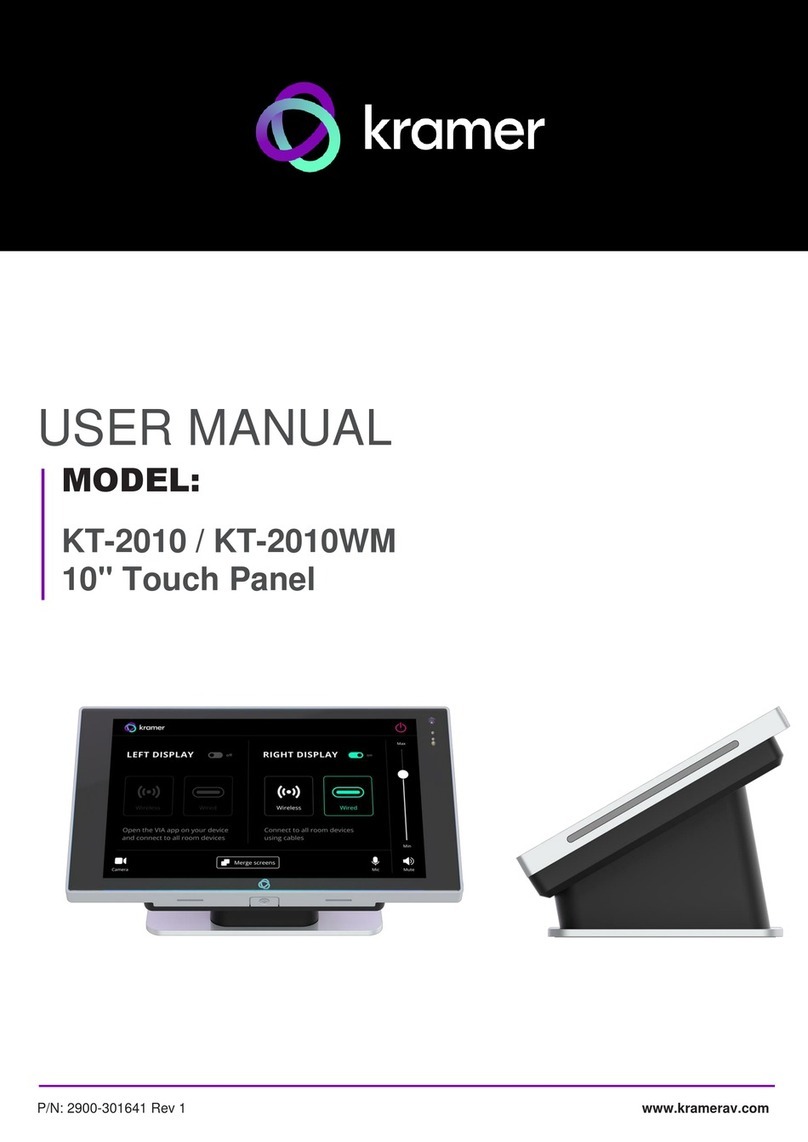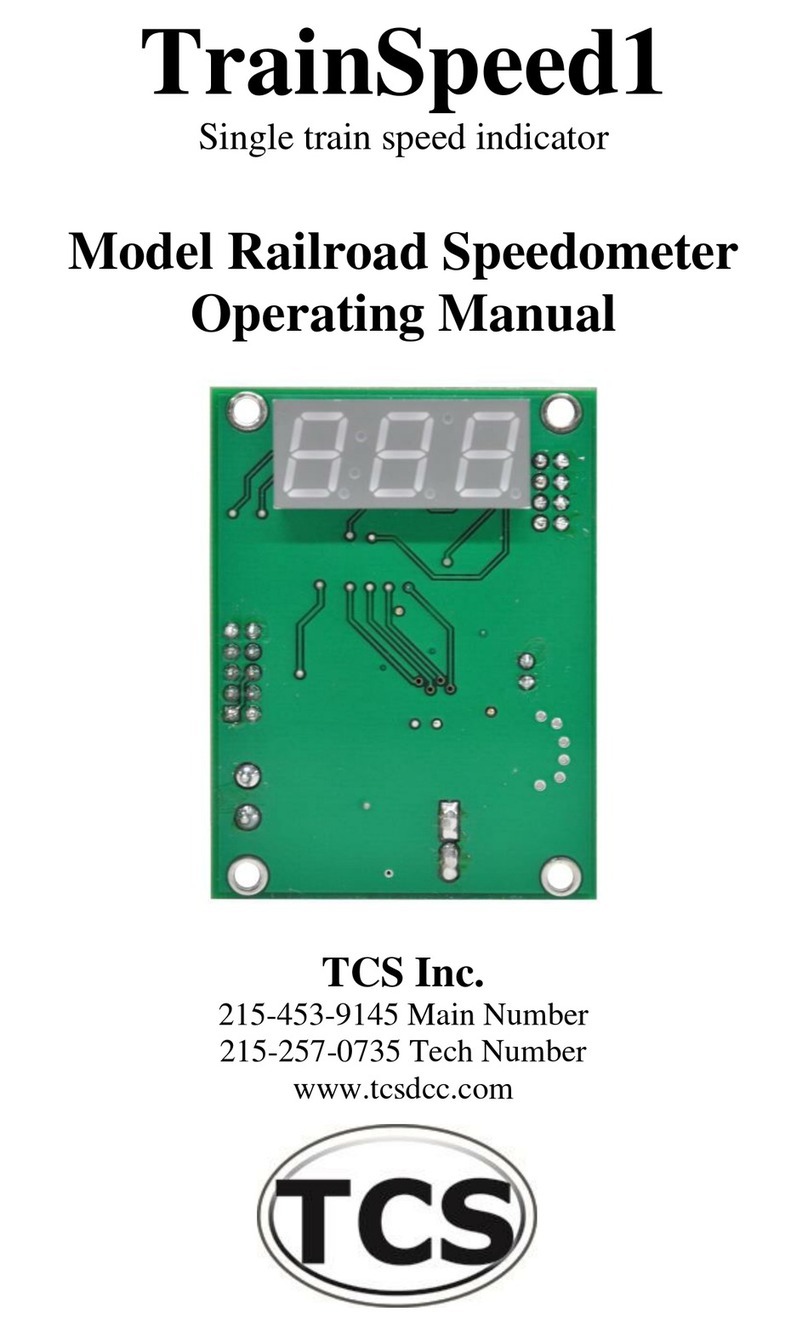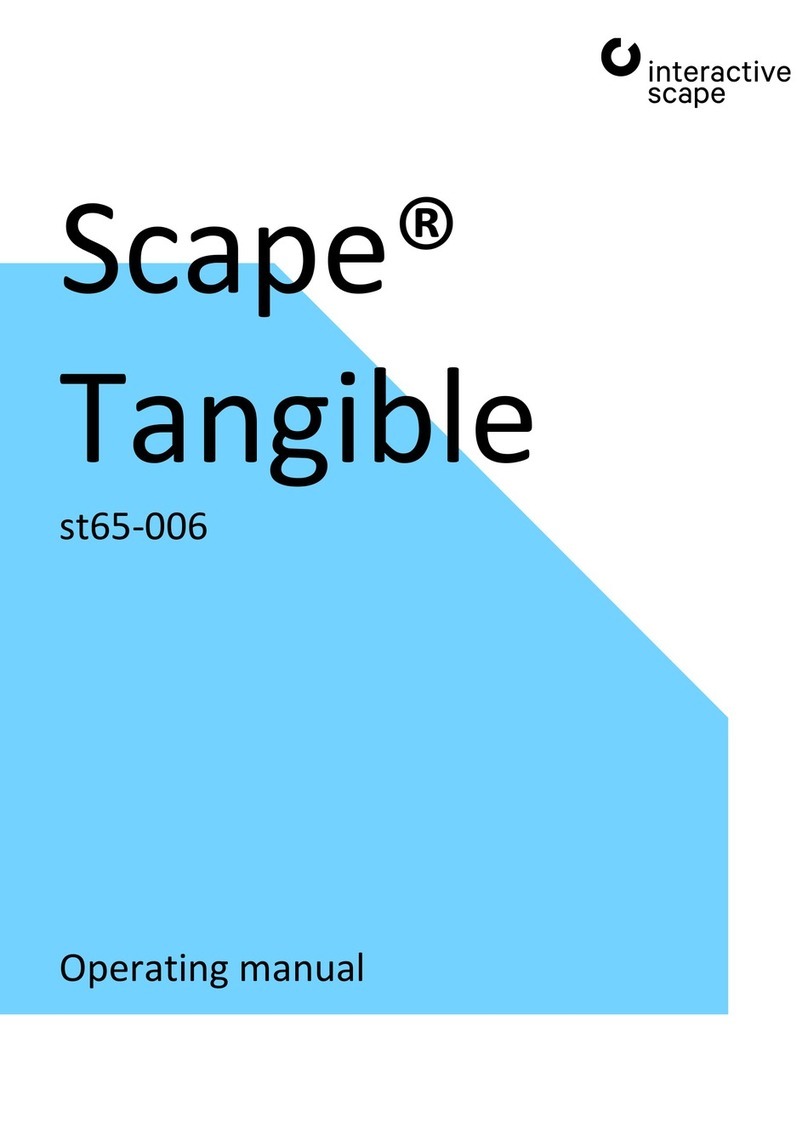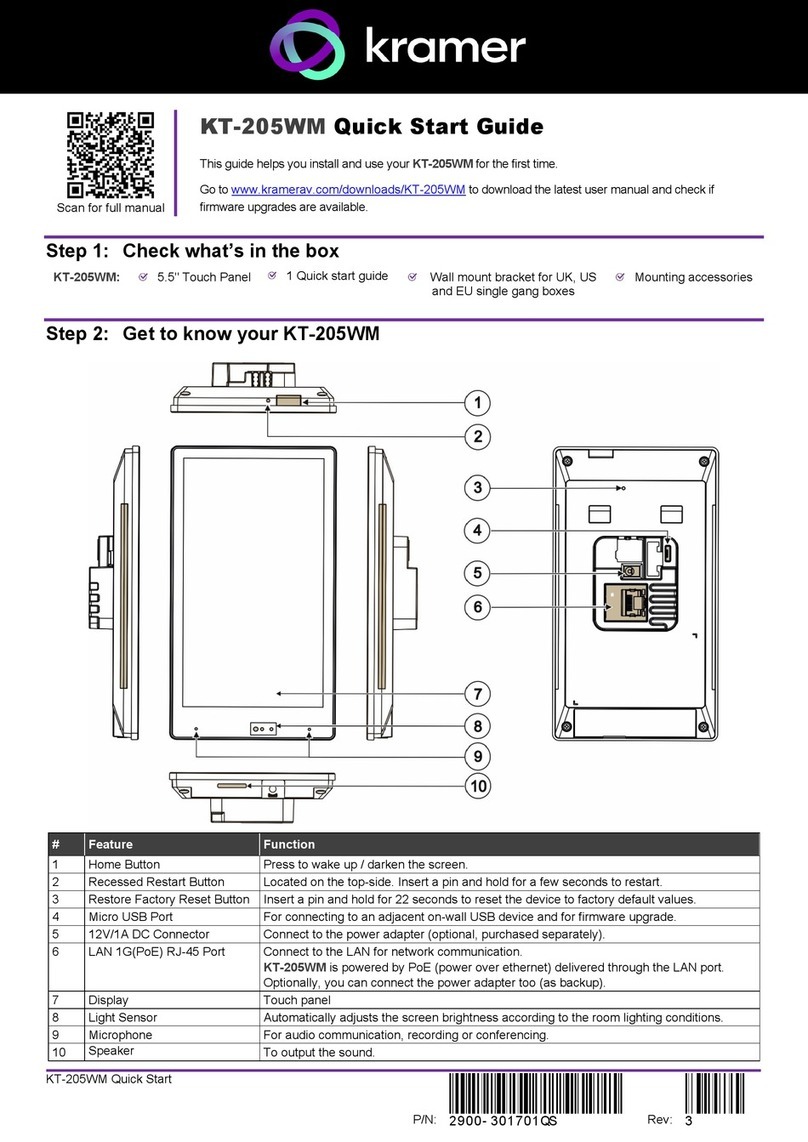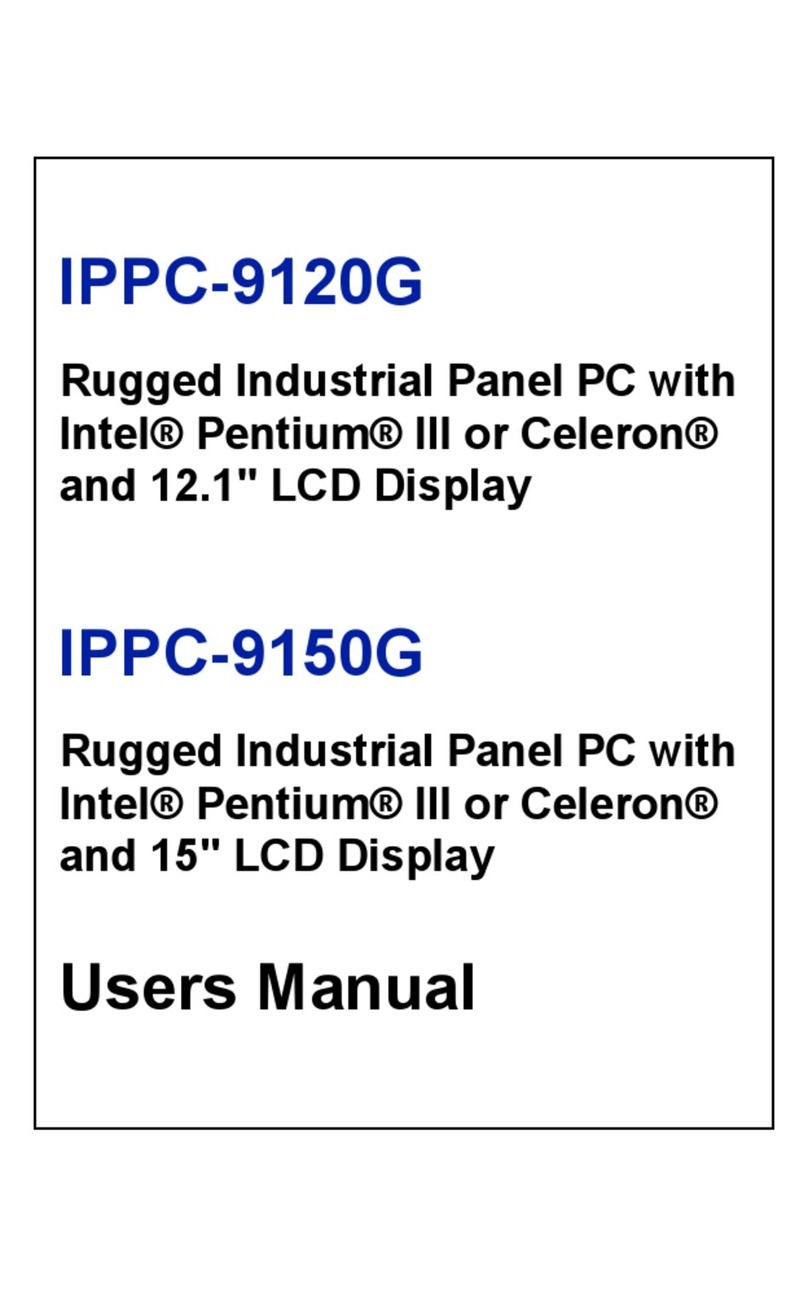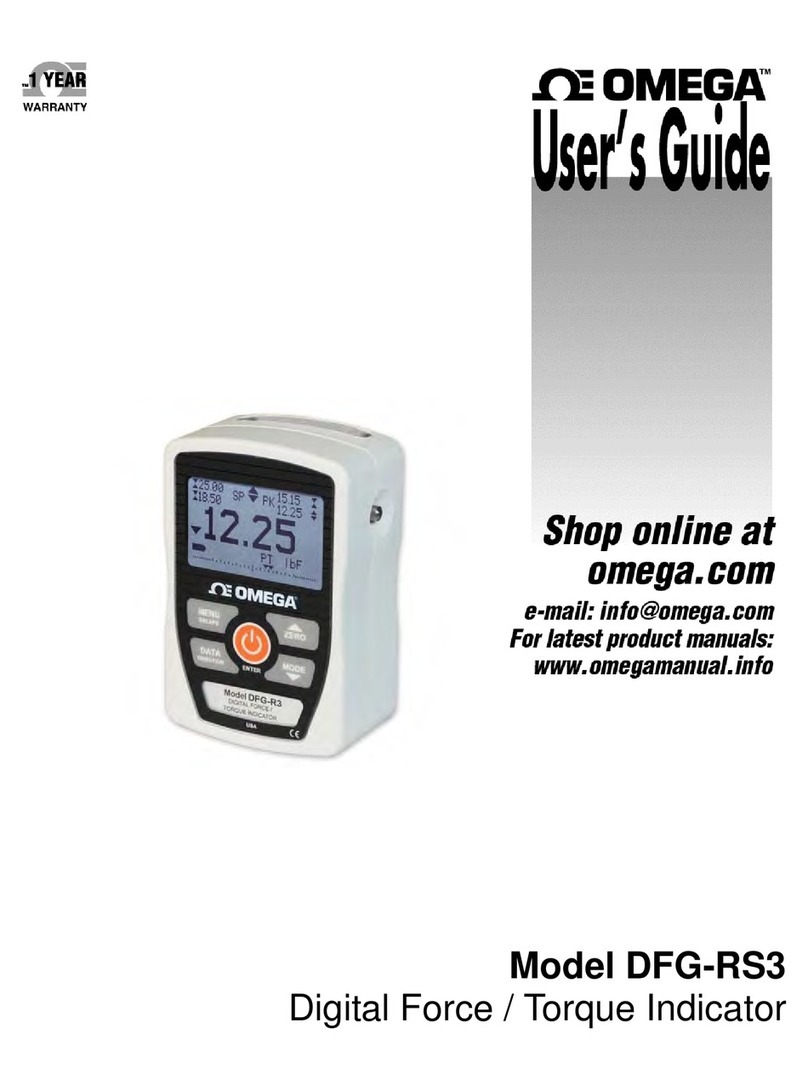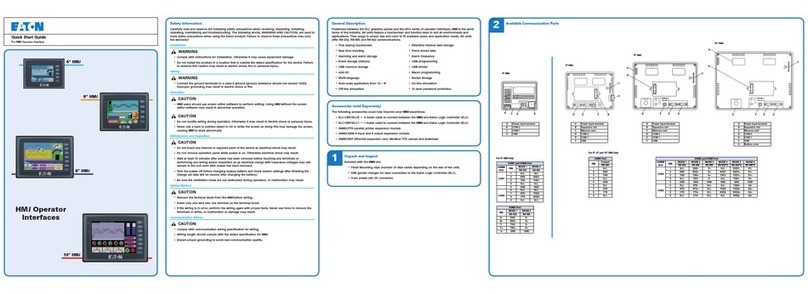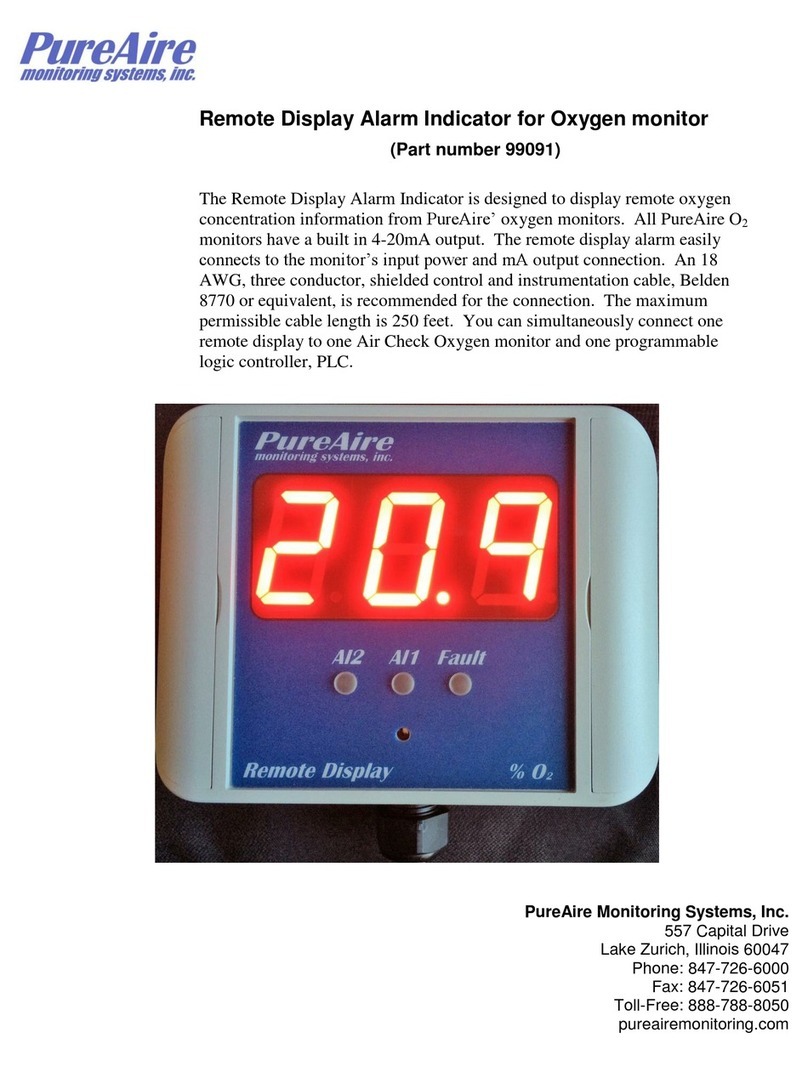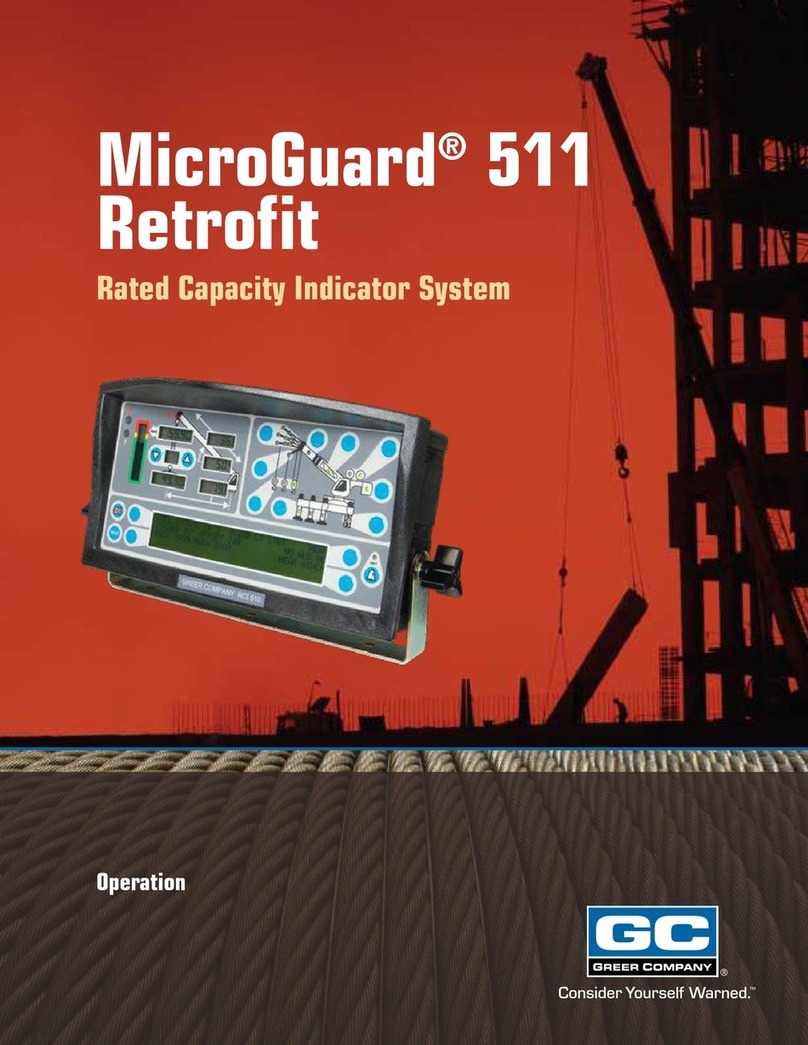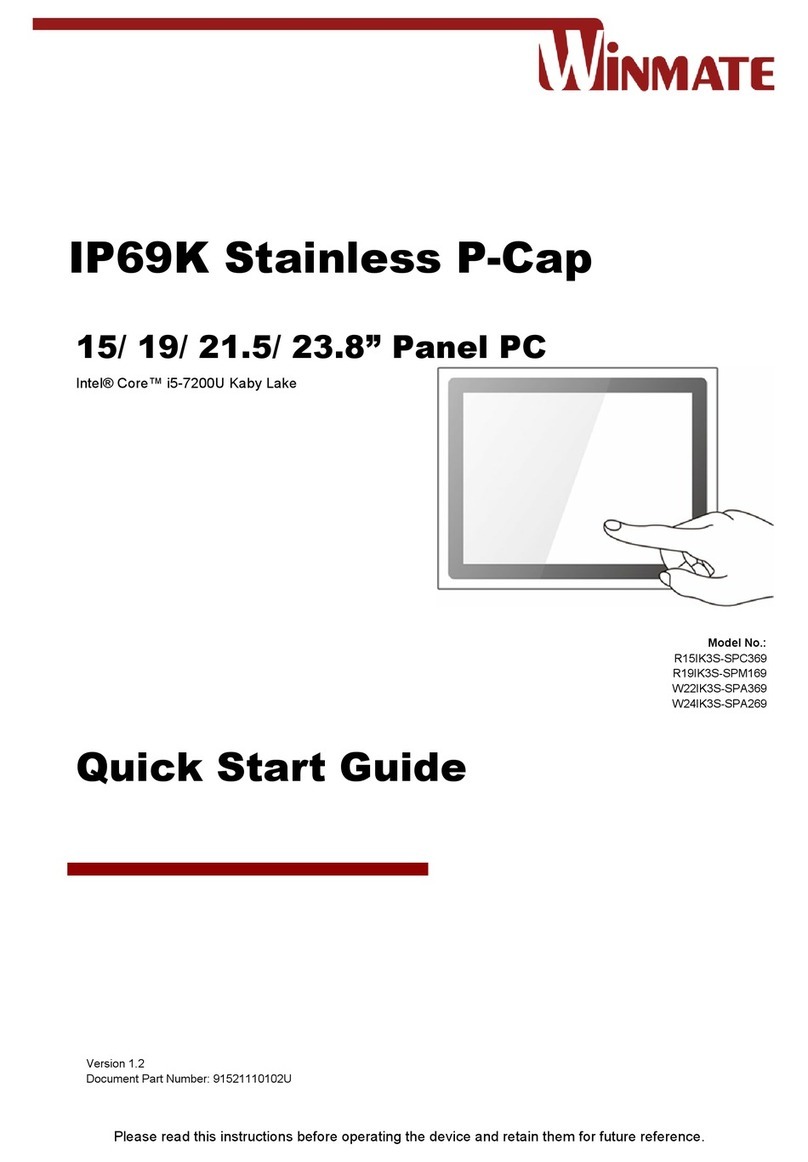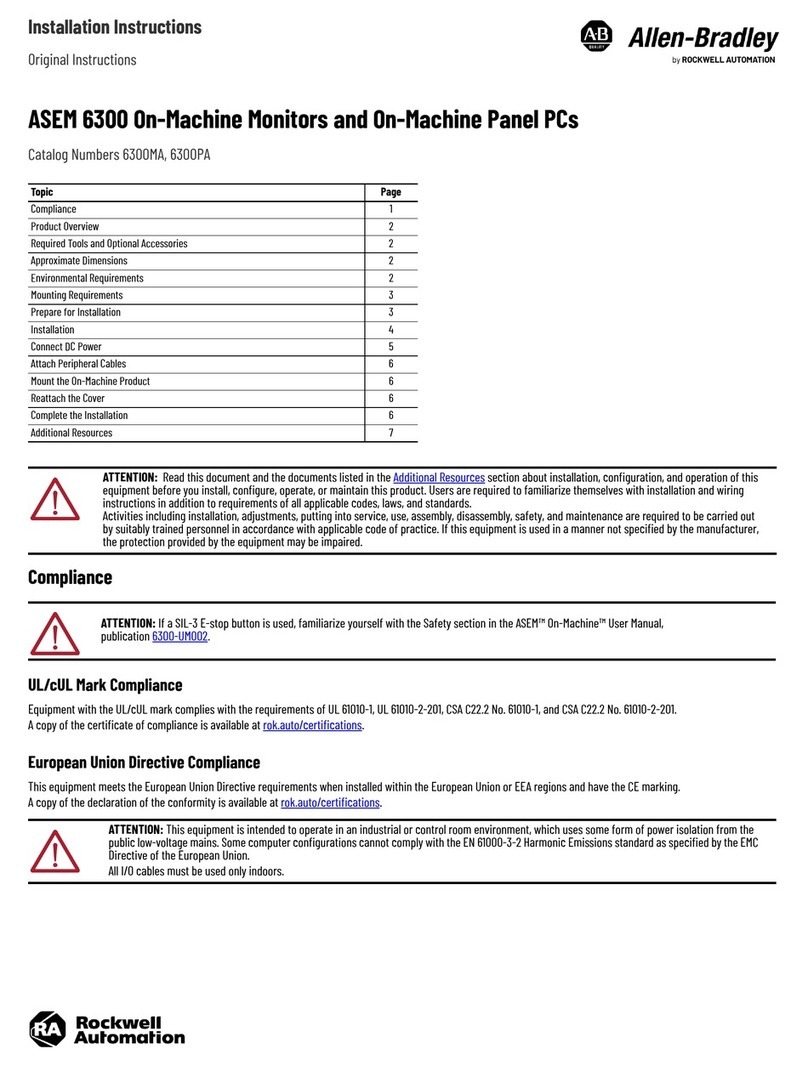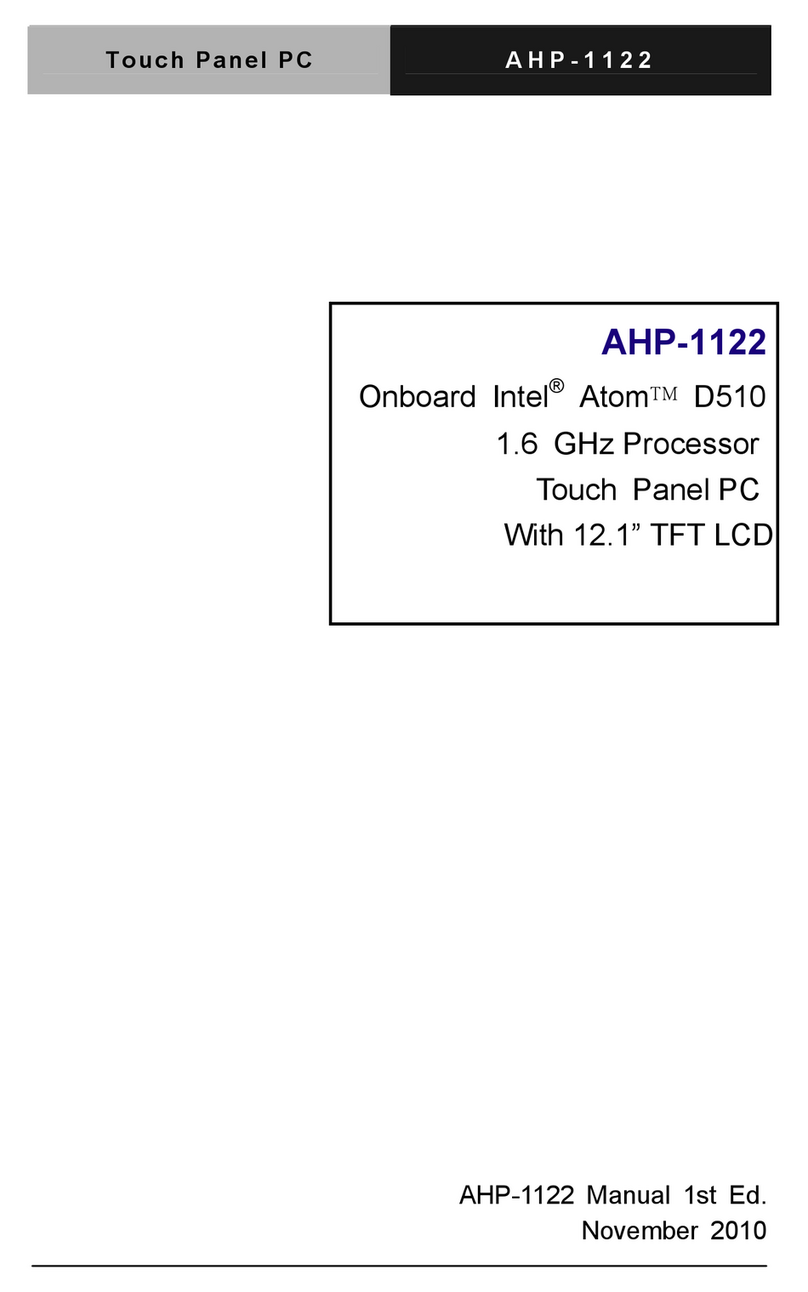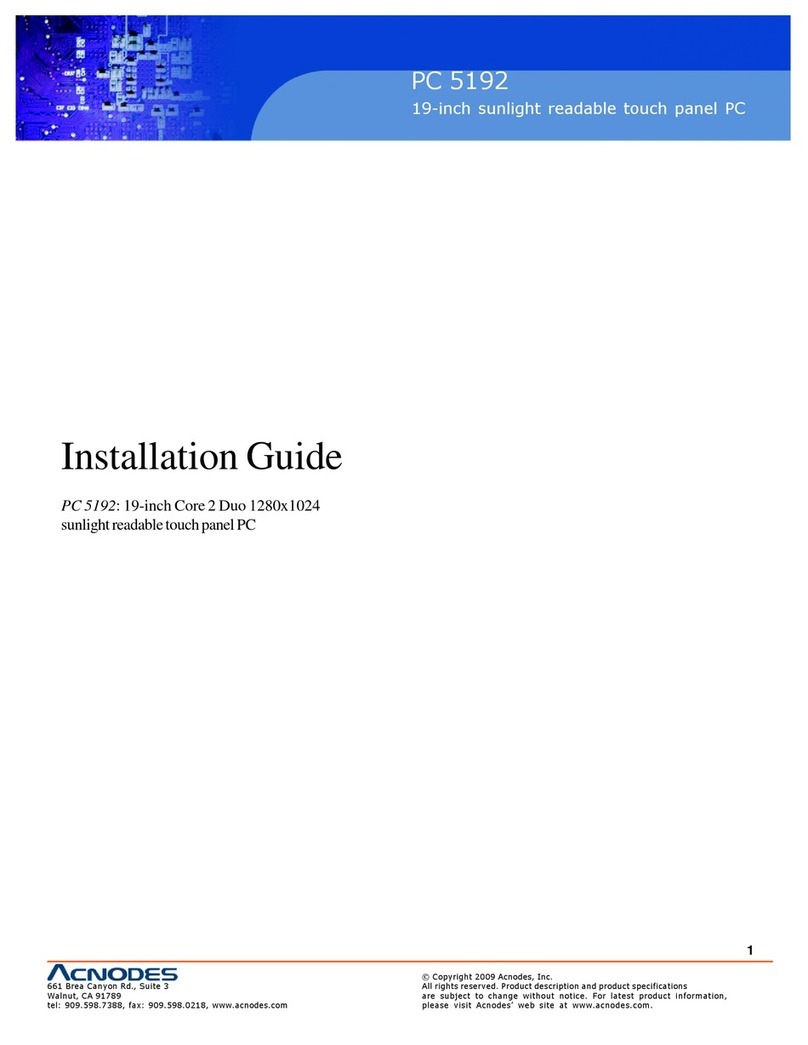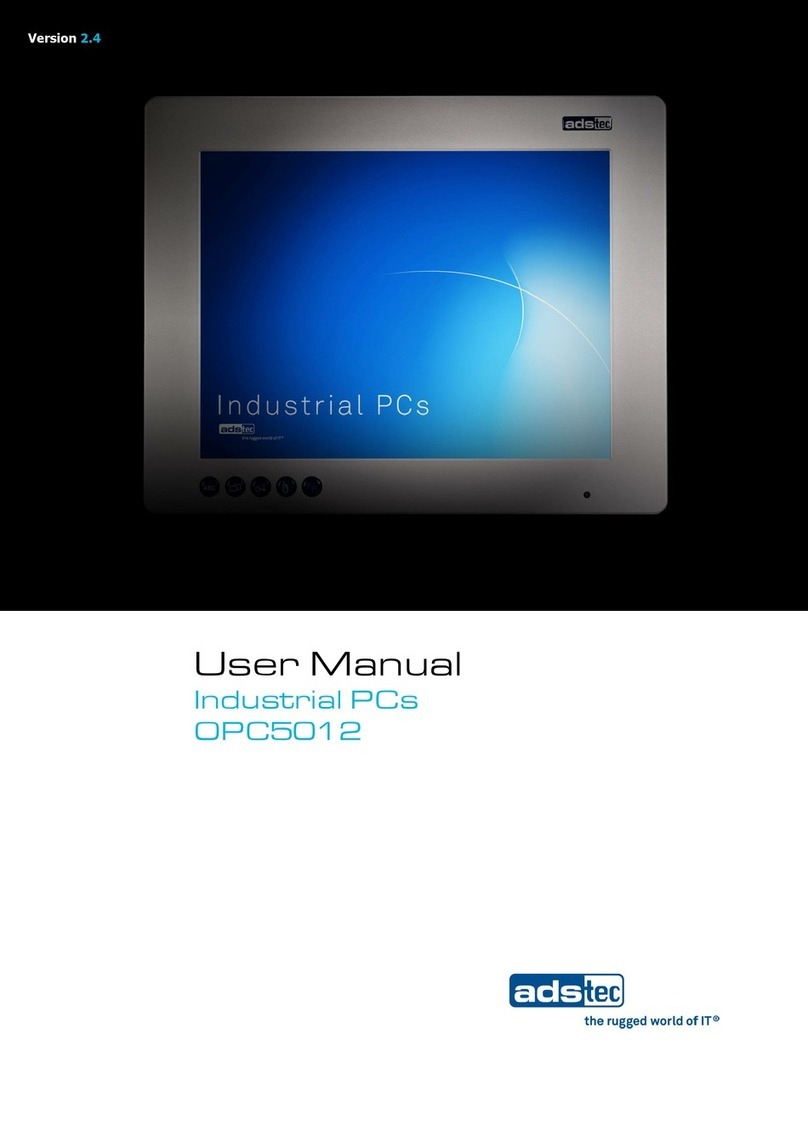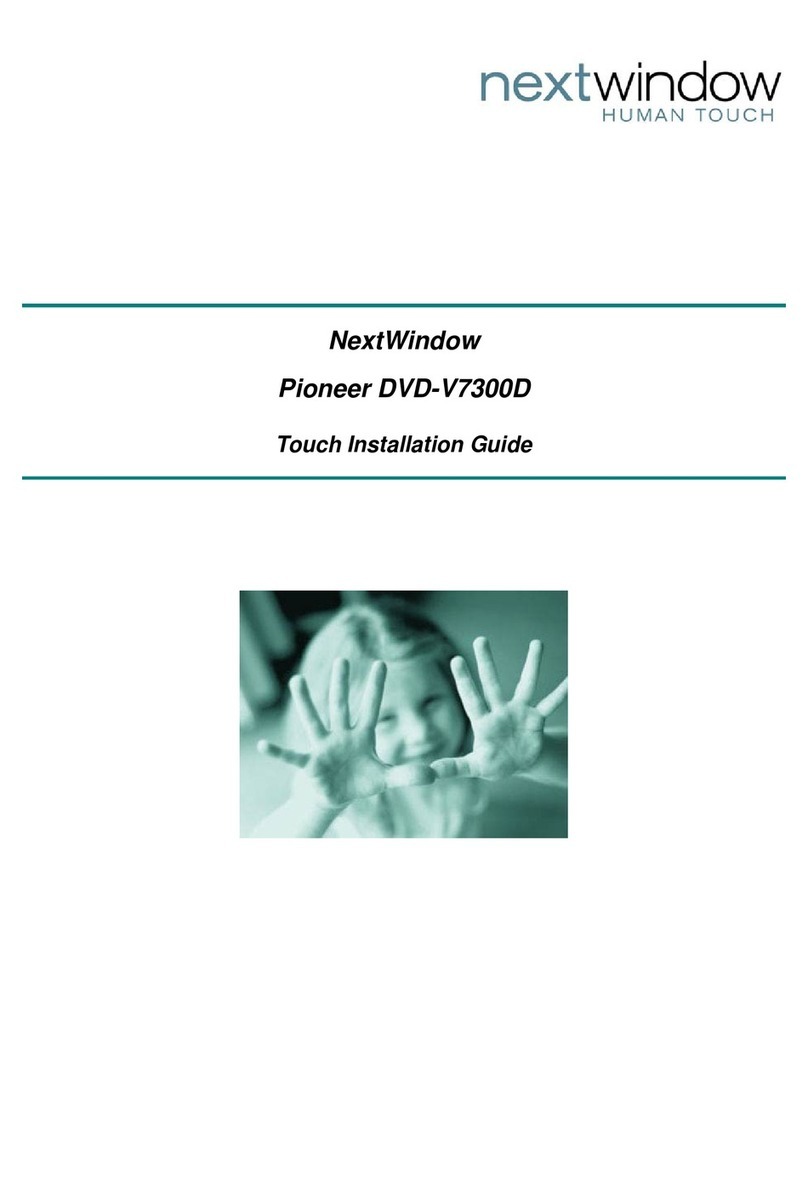EMAC PPC-E4-3354 User manual

PPC-E4-3354
ARM Cortex-A8 SOM-3354M
Based Panel PC
User Manual
REV. 1.0
Copyright 2016
EMAC, Inc.

PPC-E4-3354_User_Manual.docx -2- Rev 1.0 © 2016 EMAC, Inc.
Table of Contents
1PPC-E4-3354 Product Summary......................................................................................... 4
1.1 Features.......................................................................................................................................................4
1.2 Standard PPC Specifications.......................................................................................................................5
2PPC-E4-3354 Product Details............................................................................................. 7
2.1 Jumper Configuration & Connector Descriptions.........................................................................................7
2.2 Power Connectors........................................................................................................................................8
2.3 Ethernet........................................................................................................................................................8
2.4 Serial Ports...................................................................................................................................................8
2.5 USB Host Ports......................................................................................................................................... 10
2.6 Audio Port.................................................................................................................................................. 10
2.5 LCD Brightness Control ............................................................................................................................ 10
2.6 MicroSD Card Socket................................................................................................................................ 11
2.7 Keyboard/Mouse....................................................................................................................................... 11
2.8 Analog Inputs ............................................................................................................................................ 11
2.9 I/O Expansion............................................................................................................................................ 11
2.10 Real-Time Clock ....................................................................................................................................... 11
2.11 Serial Flash............................................................................................................................................... 12
2.12 Status LEDs and Reset............................................................................................................................. 12
2.13 CAN Port................................................................................................................................................... 12
3Software ............................................................................................................................ 13
3.1 U-Boot....................................................................................................................................................... 13
3.2 Embedded Linux ....................................................................................................................................... 13
3.2.1 Linux with Xenomai Real Time Extensions........................................................................................ 13
3.2.2 Linux Packages.................................................................................................................................. 13
3.2.3 Linux Patches .................................................................................................................................... 13
3.3 Qt Creator.................................................................................................................................................. 14
3.4 ARM EABI Cross Compiler....................................................................................................................... 14
4Appendix A: Connector Pinouts......................................................................................... 15
4.1 Ethernet 10/100 Base-T connector (JK3) ................................................................................................. 15
4.2 USB Host connector Port A & B (HDR6) .................................................................................................. 15
4.3 USB Port C OTG (JK2)............................................................................................................................. 15
4.4 Power Jack (JK1)...................................................................................................................................... 15
4.5 Power Connector (CN1)............................................................................................................................ 15
4.6 CAN Interface (CN2)................................................................................................................................. 15
4.7 LCD/Touch/Backlight (CN3)...................................................................................................................... 16
4.8 Stereo Audio Input (CN4).......................................................................................................................... 16
4.9 Stereo Audio Output (CN5)....................................................................................................................... 17
4.10 Micro SD Socket (SOK2).......................................................................................................................... 17
4.11 COM A RS-232 Serial Port (HDR4)......................................................................................................... 17
4.12 COM B RS-232 Serial Port (HDR3)......................................................................................................... 17
4.13 COM C RS-232/422/485 Serial Port (HDR2)............................................................................................ 18
4.14 COM D RS-232 Serial Port (HDR5)......................................................................................................... 18
4.15 Misc. I/O (HDR1)....................................................................................................................................... 18
5Appendix B: Jumper Settings ........................................................................................ 19
6Appendix C: Mechanical drawing with dimensions...................................................... 20

PPC-E4-3354_User_Manual.docx -3- Rev 1.0 © 2016 EMAC, Inc.
Disclaimer
EMAC Inc. does not assume any liability arising out of the application or use of any of its products or designs.
Products designed or distributed by EMAC Inc. are not intended for, or authorized to be used in, applications such
as life support systems or for any other use in which the failure of the product could potentially result in personal
injury, death or property damage.
If EMAC Inc. products are used in any of the aforementioned unintended or unauthorized applications, Purchaser
shall indemnify and hold EMAC Inc. and its employees and officers harmless against all claims, costs, damages,
expenses, and attorney fees that may directly or indirectly arise out of any claim of personal injury, death or
property damage associated with such unintended or unauthorized use, even if it is alleged that EMAC Inc. was
negligent in the design or manufacture of the product.
EMAC Inc. reserves the right to make changes to any products with the intent to improve overall quality, without
further notification.

PPC-E4-3354_User_Manual.docx -4- Rev 1.0 © 2016 EMAC, Inc.
1PPC-E4-3354 Product Summary
1.1 Features
SoM-212ES Carrier with 200 Pin SODIMM SoM Connector
Texas Instruments AM3354 ARM Cortex-A8 1Ghz processor
4GB of eMMC Flash
16 MB of Serial Flash
512MB of SDRAM
Graphic LCD & Touch Interface
Inexpensive Open-Frame Design
1x 10/100BaseT Ethernet with on-board PHY
3x RS232 ports with handshaking
1x RS232/422/485 port
2x USB 2.0 (High Speed) Host port
1x USB 2.0 (High Speed) OTG port
Battery backed Real Time Clock
1x Micro SD Flash Card Sockets
2x SPI & 1x I2C port
1x Audio Beeper
2x Timer/Counters and Pulse Width Modulation (PWM) ports
4x Channel 12-bit Analog-to-Digital converter
WQVGA LCD (480 x 272) Resolution with LED Backlight
Software Controlled Backlight On/Off & Brightness
FREE Qt Creator based IDE
Optional Power Over Ethernet (POE)
Optional I2S Audio with Line-in/out

PPC-E4-3354_User_Manual.docx -5- Rev 1.0 © 2016 EMAC, Inc.
1.2 Standard PPC Specifications
CPU: Texas Instruments AM3354 ARM Cortex-A8 processor running at 1 GHz.
Module: SOM-3354M
Carrier board: SOM-212ES
Flash: 4 GB of eMMC Flash & 16 MB SPI Flash.
RAM: 512MB of DDR3L SDRAM.
Touchscreen: 12-Bit, 4-wire analog resistive touchscreen interface.
Flash Disk: 4 GB eMMC Resident Flash
System Reset: Processor Internal Reset Management with External Reset Button provision.
RTC: Real-Time Clock Internal with battery-backed provision
Timers: 2 Timer/Counter/PWMs.
Watchdog Timer: Processor based Watchdog Timer.
Analog I/O: 8 channels total, 4 of which is shared by the resistive touchscreen.
Digital I/O: Many general purpose I/Os multiplexed with peripheral interfaces.
Power: Power Management Controller allows selectively shutting down on processor I/O functionality and
running from a slow clock.
LCD
Display Type: 4.3" TFT Color LCD
Resolution: 480 x 272 WQVGA @ 256K Colors
Dot pitch: 0.198mm x 0.198mm
Luminance: 330 (cd/m²)
Viewing Direction: 6 o'clock
Brightness: Software controlled
Backlight: White LED (10 LEDS)
Touchscreen
Type: 4 Wire Analog Resistive
Resolution: Continuous
Controller: Built-In
Driver: Linux
Transparency: 80%
Durability: Over one million touches
Ethernet interface
Ethernet MAC: Built-In
Ethernet PHY: Micrel KSZ8041NL with software PHY shutdown control
Ethernet Type: 10/100 Base-T Ethernet
Ethernet Interface: On-Board RJ-45 connector
Ethernet POE: Optional
Solid-state Flash Disk
Internal: 4GB eMMC Resident Flash
External:Standard SD Removable Flash Card interface
Mechanical and Environmental
Dimensions: 4.8 " L x 3.0" W x 1.2" H
Weight: 5.7 oz.
Power Supply Voltage: +5V DC or 8 to 35V DC.
Power Consumption: typical <~1.0A. @ 5V DC.
Operating Temperature: 0 ~ 60° C (32 ~ 140° F)

PPC-E4-3354_User_Manual.docx -6- Rev 1.0 © 2016 EMAC, Inc.
Standard Parts Inventory
PPC-E4-3354 Assembly with 4.3” Touchscreen
Molded plastic LCD mounting bracket and standoffs
SoM-3354M System on Module
Resident on-board flash disk loaded with Linux Operating System
Four Serial Port cables

PPC-E4-3354_User_Manual.docx -7- Rev 1.0 © 2016 EMAC, Inc.
2PPC-E4-3354 Product Details
2.1 Jumper Configuration & Connector Descriptions
The PPC-E4-3354 comes factory configured. In the event that jumpers need to be verified or modified this section
provides the information required, including instructions on setting jumpers and connecting peripherals, switches
and indicators. Be sure to read all the safety precautions before you begin any configuration procedure. See
Appendix A for connector pinouts and Appendix B for Jumper Settings.
Table 1: Jumpers
Label
Function
Default
JB1
Boot0 Source Selection
Position B
JB2
Boot1 Source Selection
Position A
JB3
Flash Write Protect
Position NP
JP7
COM C RS4xx RX termination
Position OPN
Table 2: Connectors
Label
Function
JK1
5Vdc Power Barrel Jack
JK2
USB OTG PortC
JK3
Ethernet
HDR1
I/O Interface
HDR2 COM C
COM 3 Serial Port
HDR3 COM B
COM 2 Serial Port
HDR4 COM A
COM 1 Serial Port
HDR5 COM D
COM 4 Serial Port
HDR6
USB Port A & B
SOK1
200 pin SOM Socket
SOK2
MicroSD Card Socket
CN1
Alternate Power Interface (5Vdc or 8 to 36Vdc)
CN2
CAN Interface
CN3
LCD &Touch Interface Cable Socket
CN4
Audio Input
CN5
Audio Output

PPC-E4-3354_User_Manual.docx -8- Rev 1.0 © 2016 EMAC, Inc.
2.2 Power Connectors
The PPC-E4-3354 provides two power connectors. CN1 is a standard four-pin type, PC floppy disk power
connector that mates with standard floppy disk drive power connectors. Using this power input provides for a
more rugged/industrial polarized locking connection. JK1 is a standard 5.5mm barrel jack with an inner diameter
of 2.1mm with a center V+ connection. This jack allows for easy connection to a 5V DC wall mount power supply
(EMAC part number PER-PWR-00032). The PPC-E4-3354’s power input uses a switching regulator and allows a
voltage input of +5V DC to 36V DC only if you are using the CN1 power connector. NOTE: If using JK1 a 5V DC
supply must be used.
To power the PPC-E4-3354 from 5V DC use either the JK1 or Pin #1 on CN1.
To power the PPC-E4-3354 from 8V to 36V DC use Pin #4 on CN1.
Alternatively the PPC-E4-3354 can be power from a Power Over Ethernet (POE) Switch
provided the SoM-212 POE option is installed.
The pinout for the CN1 power connector is as follows:
Pin Signal
1 +5V DC
2 Chassis GND
3 Chassis GND
4 +Vin DC (+8 to +36V)
Note: Do not drive both the +5V and the +Vin power inputs. Drive one or the other.
2.3 Ethernet
The PPC-E4-3354 provides 10/100 Base-T full duplex Ethernet and uses a standard RJ-45 connector. It can be
connected straight to a hub, or another computer via a crossover Ethernet cable. The Ethernet MAC is integrated
into the AM3354 ARM Cortex-A8 processor and the Micrel KSZ8041NL performs the PHY responsibilities. Activity
and Link LEDs are integrated into the RJ45 connector.
2.4 Serial Ports
The PPC-E4-3354 is equipped with three dedicated RS232 ports, all of which terminate to 10-pin header
connectors (see Table 4, 5, & 7 below) and a RS232/422/485 port (Table 6). Four 10-pin header-to-male DB9
connector cables are provided, giving easy access to these ports. Baud rate, stop bits, etc. are all programmable
for each port via software.
COM A is an RS232 compatible port with a full complement of handshaking lines allowing it to communicate with
modems and other devices requiring hardware flow control.
COM B is an RS232 port (Console Port). This port offers the RTS and CTS handshake lines.
COM C can be configured to RS232, RS422, and RS485 via four software controlled port pins (see table 3
below). To select RS232 set SoM pin 109 & 120 Low and pin 118 & 119 High (this is the default). For RS422 set
SoM pin 109 & 120 High and pin 118 & 119 Low. To select RS485, selectively set SoM pin 109 & 119 as required
while keeping pin 118 Low. The processor provides for Auto 485 by having the transmitter automatically turned on
when required, eliminating the need to manually control this line via RTS (see processor manual).
When using COM C in the RS422/485 mode, a terminating resistor (~120 Ohm) is recommended on the two far
ends of the network. JP7 moved to the TRM position will terminate the receiver with 124 ohms. For more
information on serial ports and software configuration go to:
http://wiki.emacinc.com/wiki/Example_serport212

PPC-E4-3354_User_Manual.docx -9- Rev 1.0 © 2016 EMAC, Inc.
COM D is an RS232 port. This port offers the RTS and CTS handshake lines.
Table 3
SODIMM Pin#
SoM Pin Name
Processor Pin Name(s)
Function
109
COMC_RTS
RTS2/PC9
RS422/485 Tx Enable
118
GPIO4
ISI_D3/PB23
~RS232 Shutdown
119
GPIO5
ISI_D4/PB24
~RS422/485 Rx Enable
120
GPIO6
ISI_D5/PB25
~RS232 Enable
Table 4 (COM A Pinout) (HDR4)
#
Pin Description for 10-
Pin Header
Pin Description for DB9
Connector
1
DCD
DCD
2
DSR
RxD
3
RxD
TxD
4
RTS
DTR
5
TxD
GND
6
CTS
DSR
7
DTR
RTS
8
RI
CTS
9
GND
RI
10
NC
-
Table 5 (COM B Pinout) (HDR3)
#
Pin Description for 10-
Pin Header
Pin Description for DB9
Connector
1
NC
NC
2
NC
RxD
3
RxD
TxD
4
RTS
NC
5
TxD
GND
6
CTS
NC
7
NC
RTS
8
NC
CTS
9
GND
NC
10
NC
-
Table 6 (COM C Pinout) (HDR2)
#
Pin Description for 10-Pin
Header
Pin Description for DB9
Connector
1
422/485 TX-
422/485 TX-
2
NC
232 RX, 422/485 TX+
3
232 RX, 422/485 TX+
232 TX, 422/485 RX+
4
RTS
422/485 RX-
5
232 TX, 422/485 RX+
GND
6
CTS
NC
7
422/485 RX-
RTS
8
NC
CTS
9
GND
NC
10
NC
-

PPC-E4-3354_User_Manual.docx -10- Rev 1.0 © 2016 EMAC, Inc.
Table 7 (COM D Pinout) (HDR5)
#
Pin Description for 10-Pin
Header
Pin Description for DB9
Connector
1
NC
NC
2
NC
RxD
3
RxD
TxD
4
RTS
NC
5
TXD
GND
6
CTS
NC
7
NC
RTS
8
NC
CTS
9
GND
NC
10
NC
-
2.5 USB Host Ports
The PPC-E4-3354 provides two USB 2.0, high speed host ports (PortA) and (PortB) and one USB 2.0, high speed
OTG port (PortC). USB PortA and PortB can be accessed from HDR6. PortC can be accessed from the on-board
USB connector JK2.
All of the USB ports are equipped with 500mA re-settable Polyfuses. If a USB Device tries to draw more than
500mA from the port, the fuse will open until the device is unplugged or its current requirement is reduced. There
is no software provision for shutting down power to the Ports or detecting when a port is drawing too much
current.
Note: When sizing a power supply, make sure to allow for USB Device consumption. A device can potentially
draw 500mA, therefore these devices could use a total of up to 1 amp of power.
2.6 Audio Port
The PPC-E4-3354 provides optional Audio Line Out and Line In capability through a two 4-pin 1.25mm headers
(CN4 & CN5). A special cable (included with the Audio Option) converts the signals present on the header to two
standard miniature audio jacks. The processor interfaces to the Audio CODEC through its I2S interface.
Command control of the CODEC is done using the processor’s SPI interface. The CODEC is the Cirrus CS4271,
which is a high performance 24-bit Stereo CODEC offering superior sound quality.
Both the input and output are line level. You will probably not be able to drive an unamplified speaker although
standard headphones will work. Likewise, an un-amplified microphone probably will not work as an input although
the line out of a CD player will work.
2.5 LCD Brightness Control
The PPC-E4-3354 offers LCD brightness control that can change the brightness of the LCD via software. The
LCD utilizes LED backlighting. The board provides the backlight with a constant current source of 20mA which
results in a voltage of approximately 30 volts. The processor provides a PWM (SoM Pin #85) that is used to drive
the LCD backlight. Changing the duty-cycle of the PWM directly affects the brightness of the LCD. In addition, the
backlight can be turned off by setting SoM Pin #114 low. This allows screensaver software to automatically turn
off the backlight when the unit is not being used and to automatically turn it back on when the touchscreen is
touched.

PPC-E4-3354_User_Manual.docx -11- Rev 1.0 © 2016 EMAC, Inc.
2.6 MicroSD Card Socket
The PPC-E4-3354 provides a high capacity MicroSD socket. This socket is hot-swappable and can accept a wide
variety of Flash Cards. A green activity light (LED LD2) is located towards the left side of the socket. When the
processor is accessing the Flash card, this LED will be lit and the card should not be removed at this time. A card
that is written to by the PPC-E4-3354, can be read by another computer, using a MicroSD card reader. The
MicroSD interface is compatible with Standard and High Capacity MicroSD cards.
2.7 Keyboard/Mouse
The PPC-E4-3354 does not provide a PS/2 type keyboard/mouse interface. However, a USB keyboard and
mouse can be used if required.
2.8 Analog Inputs
The analog inputs are available on HDR1 (see table below) and are labeled as analg_04, analg_05, analg_06 and
analog_07. Voltages applied to the inputs must be in the range of 0V to 3.3V with reference to ground. Different
operating systems may provide access to the analog inputs differently or even not at all. See the operating
system documentation for details. Note: In some cases using the Analog Inputs can have adverse effect on the
touchscreen sensitivity.
2.9 I/O Expansion
The Processor used by the PPC-E4-3354 provides a number of unused I/O lines. The PPC-E4-3354 provides
access to these lines on connector HDR1. This 20-pin dual row header contains GPIO lines, SPI bus, I2C bus,
A/D lines, interrupts and power pins. Signal names listed in the table below are the SoM names as defined in the
SoM 200 pin specification.
Table 8
Pin
Signal
Pin
Signal
1
GND
2
3.3V
3
I2DAT
4
I2CLK
5
~RESET_OUT
6
SPI_MISO
7
SPI_CLK
8
SPI_MOSI
9
SPI_CS1
10
SPI_CS0
11
SPI_CS3
12
GPIO07
13
ANALG_05
14
GPIO13
15
ANALG_06
16
IROA
17
ANALG_04
18
GPIO15
19
ANALG_07
20
GPIO12
2.10 Real-Time Clock
The PPC-E4-3354 emulates a real time clock using the internal real time clock on the AM3354 processor. Battery
backup is provided from the carrier board using the VSTBY pin. The real-time clock is a precise timer which can
generate interrupts on intervals specified by the user.

PPC-E4-3354_User_Manual.docx -12- Rev 1.0 © 2016 EMAC, Inc.
2.11 Serial Flash
In addition to the eMMC Resident Flash is 16MB of SPI based bootable serial flash. To select this device the
Boot1 jumper JB2 must be in the A position, Boot0 must be in the A position, and SPI0_CS0 must be active. JB3
can be used to Write Protect the serial flash when in the FWP position. The serial flash can be used to Boot from
or can be a handy place to store non-volatile configuration data. See the software drivers for details on accessing
this. Note: Use of the SPI externally can affect the booting of the system if proper interfacing is not followed.
The Module is capable of booting out of Serial, Ethernet, SPI Flash, or USB. Booting from eMMC is only possible
with a custom populated version. Contact EMAC for more details. Minimum purchase quantities apply.
2.12 Status LEDs and Reset
The PPC-E4-3354 provides a status LED on the SoM-3354M module, LD1 (Green) which is connected to
processor port pin GPIO3_4. Additionally, a Green power LED (LD1) and a SD Activity status LED (LD2) are
provided on the Carrier.
Also provided is a Reset Button (PB1). Pressing this button will cause the system to reset.
2.13 CAN Port
The PPC-E4-3354 is constructed from the SoM-3354M module and the SoM-212 carrier. The SoM-212 carrier
provides for an un-isolated CAN port (CN2). The AM3354 provides a High-End Controller (HECC) internally. The
CAN interface lines are directed to the dedicated CAN pads on the SoM connector as shown in the table below.
There is no provision for CAN network termination on the PPC-E4-3354. CAN termination should be done
externally at the two far ends of the network.
SODIMM
Pin#
SoM
Pin Name
Processor
Pin Name(s)
Port Line
Pin Description
93
CANTX
MII1_TXD3
GPIO 0_16
CAN Transmit
94
CANRX
MII1_TXD2
GPIO 0_17
CAN Receive

PPC-E4-3354_User_Manual.docx -13- Rev 1.0 © 2016 EMAC, Inc.
3Software
The PPC-E4-3354 offers a wide variety of software support from both open source and proprietary sources. The
Module hardware core utilizes the TI AM3354 processor, which is supported by Linux.
For more information on Linux Software Support, please visit the EMAC Wiki Software Section at:
http://wiki.emacinc.com/wiki/product_wiki
3.1 U-Boot
EMAC utilizes Das U-Boot for its ARM based products. U-Boot is an open source/cross-architecture platform
independent bootloader. It supports reading and writing to the flash, auto-booting, environmental variables,
and TFTP. Das U-boot can be used to upload and run and/or reflash the OS or to run stand-alone programs
without an OS. Products are shipped with a valid MAC address installed in flash in the protected U-boot
environmental variable “ethaddr”. At boot time U-Boot automatically stores this address in a register within the
MAC, which effectively provides it to any OS loaded after that point.
3.2 Embedded Linux
EMAC Open Embedded Linux is an open source Linux distribution for use in embedded systems. The EMAC
OE Linux Build is based on the Open Embedded (www.openembedded.org) Linux build system. Open
Embedded is a superior Linux distribution for embedded systems. Custom Linux builds are also available on
request.
The distribution contains everything a user could expect from a standard Linux kernel: powerful networking
features, advanced file system support, security, debugging utilities, and countless other features.
The basic root file system includes:
Busybox
Hotplugging support
APM utilities for power management
Openssh SSH server
lighttpd HTTP server
JJFS2 or EXT4 file system with utilities
3.2.1 Linux with Xenomai Real Time Extensions
Xenomai provides real time extensions to the kernel and can be used to schedule tasks with hard deadlines
and s latencies. The Xenomai build is an additional module that can be added to the standard Linux kernel
and is available for a one-time inexpensive support/installation fee.
http://www.xenomai.org/
3.2.2 Linux Packages
EMAC provides support for many Linux Packages such as: PHP, SQLite, Perl, SNMP, DHCP Server, etc. As
with the Xenomai Package, other Packages can be added to the standard Linux file system and are available
for a one-time inexpensive support/installation fee.
3.2.3 Linux Patches
In addition to standard Embedded Linux support, EMAC has released a number of patches and device drivers
from the open source community and from internal EMAC engineering into its standard distribution. Along
with kernel patches, EMAC provides the binaries for the kernel and root file system.

PPC-E4-3354_User_Manual.docx -14- Rev 1.0 © 2016 EMAC, Inc.
3.3 Qt Creator
Qt Creator is a cross-platform IDE (Integrated Development Environment) tailored to the needs of Qt
developers but works well for Headless applications as well. EMAC provides sample code as projects that
can be imported into Qt Creator. Qt Creator supports remote deployment and source debugging.
https://qt-project.org/wiki/Category:Tools::QtCreator
3.4 ARM EABI Cross Compiler
The popular open source gcc compiler has a stable build for the ARM family. EMAC uses the 4.9.1 version of
the ARM EABI compiler. The Embedded Linux kernel and EMAC Qt Creator projects use this compiler for
building ARM stand alone, and OS specific binaries. The EMAC Qt Creator provides source level debugging
over Ethernet or serial using gdbserver. The Linux binaries for the ARM EABI cross compiler are available
online along with the SDK. See the EMAC wiki for further information.

PPC-E4-3354_User_Manual.docx -15- Rev 1.5 © 2016 EMAC, Inc.
4Appendix A: Connector Pinouts
4.1 Ethernet 10/100 Base-T connector (JK3)
Pin Signal
1 XMT+
2 XMT-
3 RCV+
4 N/C
5 N/C
6 RCV-
7 N/C
8 N/C
4.2 USB Host connector Port A & B (HDR6)
Pin Signal Pin Signal
1 USB_A _ VBUS 2 USB_B _VBUS
3 USB_A _HOST+ 4 USB_B _HOST+
5 USB_A _HOST- 6 USB_B _HOST-
7 GND 8 GND
9 NC 10 NC
4.3 USB Port C OTG (JK2)
Pin Signal
1 USB_OTG_VBUS
2 USB_Data-
3 USB_Data+
4 USB_OTG_ID
5 GND
4.4 Power Jack (JK1)
Pin Signal
Center 5V DC
Barrel GND
4.5 Power Connector (CN1)
Pin Signal
1 5V DC
2 GND
3 GND
4 +Vin (+8v to 36V)
4.6 CAN Interface (CN2)
Pin Signal
1 CAN+
2 CAN-
3 GND

PPC-E4-3354_User_Manual.docx -16- Rev 1.0 © 2016 EMAC, Inc.
4.7 LCD/Touch/Backlight (CN3)
Pin Signal
FN1 GND1 GND
2 BCKLT_LEDA
3 GND
4 3.3V
5 RED0_R
6 RED1_R
7 RED2_R
8 RED3_R
9 RED4_R
10 RED5_R
11 RED6_R
12 RED7_R
13 GREEN0_R
14 GREEN1_R
15 GREEN2_R
16 GREEN3_R
17 GREEN4_R
18 GREEN5_R
19 GREEN6_R
20 GREEN7_R
21 BLUE0_R
22 BLUE1_R
23 BLUE2_R
24 BLUE3_R
25 BLUE4_R
26 BLUE5_R
27 BLUE6_R
28 BLUE7_R
29 GND
30 LCDCLOCK_R
31 LCDPWR_ON/~OFF
32 NC
33 NC
34 LCDEN_R
35 NC
36 GND
37 TOUCHF_X+
38 TOUCHF_Y+
39 TOUCHF_X-
40 TOUCHF_Y-
FN2 RGND
4.8 Stereo Audio Input (CN4)
Pin Signal
1 Right In
2 GND
3 GND
4 Left In

PPC-E4-3354_User_Manual.docx -17- Rev 1.0 © 2016 EMAC, Inc.
4.9 Stereo Audio Output (CN5)
Pin Signal
1 Right Out
2 GND
3 GND
4 Left Out
4.10 Micro SD Socket (SOK2)
Pin Signal
1 DAT2
2 CD/DAT3
3 CMD
4 VCC (3.3V)
5 SCLK
6 GND
7 DAT0
8 DAT1
9 SD Card Detect
4.11 COM A RS-232 Serial Port (HDR4)
Pin HD3 Signal DB9 Signal
1 DCD DCD
2 DSR RxD
3 RxD TxD
4 RTS DTR
5 TxD GND
6 CTS DSR
7 DTR RTS
8 RI CTS
9 GND RI
10 NC -
4.12 COM B RS-232 Serial Port (HDR3)
Pin HD3 Signal DB9 Signal
1 NC NC
2 NC RxD
3 RxD TxD
4 RTS NC
5 TxD GND
6 CTS NC
7 NC RTS
8 NC CTS
9 GND NC
10 NC --

PPC-E4-3354_User_Manual.docx -18- Rev 1.0 © 2016 EMAC, Inc.
4.13 COM C RS-232/422/485 Serial Port (HDR2)
Pin HD3 Signal DB9 Signal
1 422/485 TX- 422/485 TX-
2 NC 232 RX, 422/485 TX+
3 232 RX, 422/485 TX+ 232 TX, 422/485 RX+
4 RTS 422/485 RX-
5 232 TX, 422/485 RX+ GND
6 CTS NC
7 422/485 RX- RTS
8 NC CTS
9 GND NC
10 NC -
4.14 COM D RS-232 Serial Port (HDR5)
Pin HD3 Signal DB9 Signal
1 NC NC
2 NC RxD
3 RxD TxD
4 RTS NC
5 TxD GND
6 CTS NC
7 NC RTS
8 NC CTS
9 GND NC
10 NC --
4.15 Misc. I/O (HDR1)
Pin Signal Pin Signal
1 GND 2 3.3V
3 I2DAT 4 I2CLK
5 RESET_OUT 6 SPI_MI
7 SCLK 8 SPI_MOSI
9 SPI_CS1 10 SPI_CS0
11 SPI_CS3/FRM 12 GPIO07
13 ANALG_05 14 GPIO13
15 ANALG_06 16 IROA
17 ANALG_04 18 GPIO15
19 ANALG_07 20 GPIO12

PPC-E4-3354_User_Manual.docx -19- Rev 1.0 © 2016 EMAC, Inc.
5 Appendix B: Jumper Settings
JB1 Boot Source Selection
Jumper Position Setting
Pins 2 & 3 A Line pulled LOW
Pins 1 & 2* B Line pulled HIGH
* Default setting
JB2 Boot Option Selection
Jumper Position Setting
Pins 2 & 3* A Line pulled LOW
Pins 1 & 2 B Line pulled HIGH
* Default Setting
JB3 Flash Write Protect Selection
Jumper Position Setting
Pins 1 & 2 A Flash Write Disable
Pins 2 & 3* B Flash Write Enable
* Default Setting
JP7 COM C RS4xx termination
Jumper Position Setting
Pins 1 & 2 TRM Terminated with 124 ohms
Pins 2 & 3* OPN Open (no termination)
* Default Setting

PPC-E4-3354_User_Manual.docx -20- Rev 1.0 © 2016 EMAC, Inc.
6Appendix C: Mechanical drawing with dimensions
Table of contents
Other EMAC Touch Panel manuals
